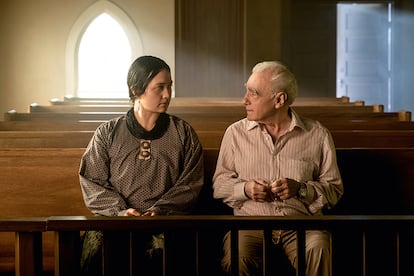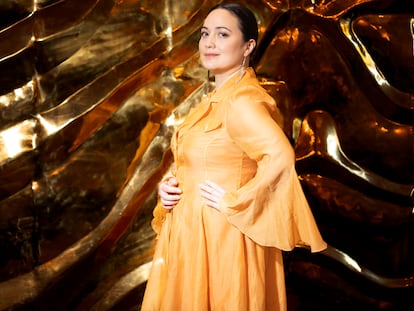Lily Gladstone’s Oscar nomination is a step towards addressing the history of humiliation and lies Hollywood has foisted upon Indigenous people
The first Indigenous person from the lands known as the United States to be nominated for Best Actress revives the debate around her community’s sparse representation in the cinematographic industry


Lily Gladstone will make history on Sunday when she walks down the Oscars’ red carpet, whether or not she leaves Los Angeles’s Dolby Theater with a statuette in hand. The presence of the 37-year-old actress, who has Siksikaitsitapi and Niimi’iipu heritage, marks a new chapter in the long and tortuous relationship between Hollywood and Indigenous peoples. Their interactions, first written into cinematographic history by the Western genre, have been marked by humiliations, manipulations and lies.
Gladstone plays Mollie Kyle in Martin Scorsese’s Killers of the Flower Moon, a woman from the Oklahoma-based Osage tribe who marries a white man, in a story inspired by real-life events. Kyle witnesses tragedy beat down on her family after their reservation is found to be rich in oil reserves. Scorsese’s Western, the first of the 81-year-old director’s legendary career, is one of this year’s Oscar frontrunners with 10 nominations, a number bested only by Poor Things and Oppenheimer. Gladstone stands a good chance of taking the Best Actress category, and performer Scott George will also appear for a live performance of the film’s closing number Wahzhazhe, nominated for Best Song.
But even if Gladstone comes away empty-handed from Sunday’s gala event, the actress won’t have gone unnoticed during awards season. She won a Golden Globe and recognition from the actor’s union, SAG-AFTRA. “This is for every rez kid, every little urban kid, every little Native kid out there who has a dream,” she said in her Golden Globes acceptance speech in January.
Her words spoke to the actress’ personal experience. Gladstone lived on the Blackfoot reservation in Montana until she was 11 years old. Her family then moved to a suburb north of Seattle, where she discovered her passion for ballet and began to act through community theater groups. In 2016, she joined the cast of celebrated independent filmmaker Kelly Reichardt’s Certain Women. That was where Scorsese saw her potential after Ellen Lewis, his casting director, recommended him the film.
Gladstone is the first Indigenous person from the lands known as the United States to be nominated for Best Actress, after New Zealander Keisha Castle-Hughes’s nod for Whale Rider, and Mexican actress Yalitza Aparicio’s nomination for Roma. Her presence on Hollywood’s big night is a statistical anomaly. Indigenous actors are barely represented in the industry. They’ve played only 133 out of the 62,000 speaking roles in the last 16 years’ worth of films. That’s 0.25%, according to a diversity report published by the University of Southern California, which calls the percentage “disheartening at best or tragic at worst.” The figure comes despite the fact that some 2.8% of U.S. residents, some 9.6 million people, claim some Indigenous heritage.
Indeed, we almost missed the chance to meet Mollie Kyle. Gladstone’s character only appeared during three scenes in the first script she saw back in 2019. But Scorsese took advantage of the pandemic to shift the story’s focus to the story of her marriage to Ernest, played by Leonardo DiCaprio.
The country’s Indigenous people have not been invited to Hollywood’s so-called new commitment to diversity. The university study found that only 64 actors with Indigenous heritage worked on the 1,600 films made between 2007 and 2022, 45 men and only 19 women. One of them played a leading role. “Killers of the Flower Moon has an importance that goes beyond what the media reports on. It represents a critical opportunity to see a story centered on the experience of a Native woman and for all those who wish to work in Hollywood,” says the report’s author, Stacy Smith.
If Gladstone does ascend to the Oscars stage, it will be the first time an Indigenous person from the United States will have done so since 1973, when Sacheen Littlefeather stood beneath the lights of the ceremony to decline the prize that Marlon Brando had won for The Godfather. “As she spoke, she heard a commotion backstage,” related The New Yorker in a 2022 interview with Littlefeather, the year that the Academy organized a tribute to ask her for forgiveness. Brando boycotted the awards because of the industry’s treatment of Native people and the construction of a South Dakota military base in Sioux territory. New Yorker journalist Michael Schulman briefly recalled the episode in his book Oscar Wars, published last year. Although it was “widely ridiculed,” Schulman writes, the protest was a triumph for guerrilla-style activism, and opened the door to decades of political discourse on Oscar night.
Film historian and critic Farran Smith Nehme disputes reports that John Wayne tried to launch himself at Littlefeather during the ceremony. But Clint Eastwood, who has since taken up Wayne’s baton as Hollywood’s top conservative, scoffed at her gesture as he presented the night’s final Oscar, joking that he was on stage in memory of “all the cowboys shot in all the John Ford Westerns.”
You have to go back to 1971, two years before Littlefeather’s night, to find the first Native recognized by Hollywood. Canadian Dan George, chief of the Tsleil-Waututh tribe, was nominated for Best Supporting Actor for Little Big Man, but lost. It would be decades before another Native person, Graham Greene, was nominated for Dances With Wolves, which swept the awards in 1991, winning seven statuettes. Greene was out of luck, and the award went to Joe Pesci for Goodfellas.
Pretendians
Littlefeather died in October 2022, weeks after the Academy’s tribute to her. The San Francisco Chronicle would later publish an interview with the supposed Apache activist’s biological sisters. “My father was who he was. His family came from Mexico. And my dad was born in Oxnard (northeast of Los Angeles),” said Trudy Orlandi. “It was more prestigious [to Sacheen] to be an American Indian than it was to be Hispanic in her mind,” she continued.
Such controversy is not uncommon in Hollywood, where one’s identity can be a factor used to set oneself apart in a highly competitive environment. A similar uproar took place over Iron Eyes Cody, an actor who died in 1999 after acting in a hundred Westerns, among them Sitting Bull (1954) and The Paleface (1948), in addition to a popular television ad in 1971 in which he was seen shedding a tear over a polluted landscape. A journalistic investigation revealed in 1996 that he had no links to any Native tribes and, in reality, was the son of Sicilian migrants who was born in Louisiana.
One of the most recent cases of the Pretendians took place in March of last year. An organization named Tribal Alliance denounced Heather Rae, an independent producer who claimed to have Cherokee blood, an affiliation that allowed her to form part of the Sundance Indigenous Program, and another Academy organization focused on diversity. The activist group claimed that Rae came from six generations of white people, which forced her to undergo genetic analysis and eventually modify her narrative to identify herself as an “ally” of Indigenous people.
Sign up for our weekly newsletter to get more English-language news coverage from EL PAÍS USA Edition
Tu suscripción se está usando en otro dispositivo
¿Quieres añadir otro usuario a tu suscripción?
Si continúas leyendo en este dispositivo, no se podrá leer en el otro.
FlechaTu suscripción se está usando en otro dispositivo y solo puedes acceder a EL PAÍS desde un dispositivo a la vez.
Si quieres compartir tu cuenta, cambia tu suscripción a la modalidad Premium, así podrás añadir otro usuario. Cada uno accederá con su propia cuenta de email, lo que os permitirá personalizar vuestra experiencia en EL PAÍS.
¿Tienes una suscripción de empresa? Accede aquí para contratar más cuentas.
En el caso de no saber quién está usando tu cuenta, te recomendamos cambiar tu contraseña aquí.
Si decides continuar compartiendo tu cuenta, este mensaje se mostrará en tu dispositivo y en el de la otra persona que está usando tu cuenta de forma indefinida, afectando a tu experiencia de lectura. Puedes consultar aquí los términos y condiciones de la suscripción digital.
More information
Archived In
Últimas noticias
Welcome to the post-religion era: The idea of Christianity as the absolute truth has become obsolete
‘I thought you would like it’: The risky sexual practice popularized by TV shows and TikTok
The digitalization of tourism: ‘They promise experiences and gave us the worst possible one’
Mexican peso defies uncertainty with forecasts of a new period of stability in 2026
Most viewed
- Sinaloa Cartel war is taking its toll on Los Chapitos
- Reinhard Genzel, Nobel laureate in physics: ‘One-minute videos will never give you the truth’
- Oona Chaplin: ‘I told James Cameron that I was living in a treehouse and starting a permaculture project with a friend’
- Why the price of coffee has skyrocketed: from Brazilian plantations to specialty coffee houses
- Silver prices are going crazy: This is what’s fueling the rally










































